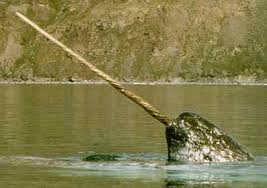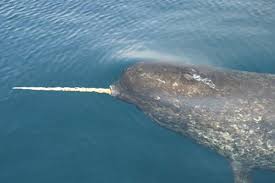The narwhal (Monodon monoceros) is a species of toothed whale found in the water nears Greenland and Canada.
Physical Features Tusk of a narwhal
 The narwhal is a stocky toothed whale, measuring about 13 feet to 16 feet. They weigh 1,600 kilograms. Males are larger than females. Narwhals don not have any dorsal fin. They have short flippers. Narwhals have patches of gray-green, cream and black on their body. Only males have a long, unique and spiral tusk. The narwhal is called the unicorn of the sea because of its long and spiral tusk which was believed to be a horn of a unicorn until the 19th century. Narwhals have two teeth, but in males one of the tooth becomes like a long sword-like tusk. Their long tusk can grow 2.7 meter (8.8 feet). They use their tusks to impress females or battle other males. Scientists are still not sure for what they use it.
The narwhal is a stocky toothed whale, measuring about 13 feet to 16 feet. They weigh 1,600 kilograms. Males are larger than females. Narwhals don not have any dorsal fin. They have short flippers. Narwhals have patches of gray-green, cream and black on their body. Only males have a long, unique and spiral tusk. The narwhal is called the unicorn of the sea because of its long and spiral tusk which was believed to be a horn of a unicorn until the 19th century. Narwhals have two teeth, but in males one of the tooth becomes like a long sword-like tusk. Their long tusk can grow 2.7 meter (8.8 feet). They use their tusks to impress females or battle other males. Scientists are still not sure for what they use it.Diet
The narwhal is a carnivore. They have a very restricted diet. They eat arctic and polar cods, squids like gonatus squid and sometimes Greenland halibuts. The additional items found in their stomach are wolf fish, capelines and skate eggs. Sometimes, stones are found in the stomach as the narwhals accidentally ingested while they feed near the bottom.
Life Cycle
Narwhals are mammals like all whales. Females give birth to one young every 3 years after a gestation period of 15 months. When a calf is born, the calf will weigh about 80 kilograms and measure 5 feet. The calf is weaned at 20 months. Narwhals mature at the age of 8 years. They have a life span of 40 years.
Behavior
Narwhals are seen in groups of 20 animals. Sometimes they separate the group according t age and gender. Their are sometimes gathering of many hundreds. When narwhals are on their wintering grounds, they dive about 800 meter (2,625 feet) deep over 15 times a day, with many of the dives reaching almost 5,000 feet. The narwhal might have the deepest dive of any marine mammal. In summer ground, the dive 9000 feet deep. They make clicks or squeals for communication or navigation.
Distribution and Habitat
The narwhal is in cold arctic seas, normally near sea ice. They are found from western Greenland to mid-eastern Canada.
Conservation Status
The narwhal is rated as 'Near Threatened' by IUCN. They have a population of about 75,000 individuals. Humans poach them for their skin and their long tusks for Vitamin C which is used in the traditional Arctic diet.
Source of picture 1:http://epedia.pbworks.com/w/page/6985889/Narwhal
Source of picture 2:http://s606.photobucket.com/albums/tt150/porschadani/?action=view¤t=NarwhalTusk.jpg&mediafilter=images

No comments:
Post a Comment